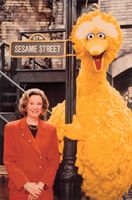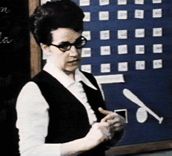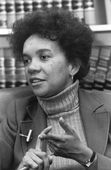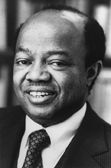

|
 |

December 15, 1999
1960s
Mary S. Calderone | Willis W. and Ethel M. Clark | James S. Coleman | James P.
Comer | James B. Conant | Joan Ganz Cooney | Lawrence A.
Cremin | Marian Wright Edelman | Jane Elliott | Rudolf F. Flesch | Milton
Friedman | Mel and Norma Gabler | John Holt | Lyndon B. Johnson
| Jonathan Kozol | Marvin
L. Pickering | Edward and Sidney Schempp |
Albert Shanker | B.F.
Skinner | John F. and Mary Beth Tinker
A Letter to
Johnny's Mom:
Rudolf F. Flesch |
| Nearly 45 years after Rudolf Flesch created
a fictional 12-year-old
boy and held him up as an indictment of elementary education in
the United States, Why
Johnny Can't Read is still used as ammunition in the battle
over how children should
be taught to read. In the book, Flesch, a writer and
consultant who had emigrated from
Austria in 1938, advocated the phonics method of instructing
children in the alphabet and
basic sounds. He likened learning to read to learning to drive.
In both, he argued,
students must first learn the basics-the mechanics of a car or
the mechanics of the
language-before taking the driver's seat.
The problem with the reading instruction most U.S. students
received at the time,
Flesch believed, was that few of them were learning those initial
skills.
"The teaching of reading-all over the United States, in
all the schools, in all
the textbooks-is totally wrong and flies in the face of all logic
and common sense,"
he wrote in the 1955 volume.
"Johnny's only problem was that he was unfortunately
exposed to an ordinary
American school."
The book begins with a letter to Johnny's mother, and includes
lessons and step-by-step
instructions for parents.
A commercial success in its time, the book has become a
manifesto for parents seeking a
return to "the basics" in reading instruction.
But it has angered many educators, who say it endorses the
kind of drilling in letters
and sounds that they contend impedes real learning and takes the
fun out of reading.
Flesch repeated his arguments in his 1981 sequel, Why
Johnny Still Can't Read,
in which he included what he said were alarming new statistics on
illiteracy.
The original "Johnny" book has been reprinted
several times, most recently in
1994. Other books by Flesch, who died in 1986 at age 75, also
focused on the use of
language and literacy. In all his volumes, he promoted his own no-
nonsense style, as
evident in the titles: The Art of Plain Talk, How to
Make Sense, The Art
of Clear Thinking, and Say What You Mean.
—Kathleen Kennedy Manzo |
Albert Shanker
The tumultuous New
York City teachers' strike of 1968 catapulted the leader of the
United Federation of Teachers to national prominence. As the
president of the American Federation of Teachers from 1974 until his
death in 1997, Shanker became an outspoken elder statesman of
education and an advocate for high standards, tough tests, and school
discipline.
B.F.
Skinner
Leading exponent of behaviorism, which views
learning as a process of responding to stimuli. Behaviorists believed
that process could be studied through laboratory observations. Such
theories guided many psychologists and education researchers from the
1950s to the 1970s.
Marian Wright
Edelman
Once described by The Washington Post as
"the most influential children's advocate in the country," Edelman
was
a prominent Mississippi civil rights lawyer in the 1960s. After
moving
to Washington in 1968, she founded the Children's Defense Fund in
1973. Through the nonprofit organization, she has fought for better
maternal care and child health care, improved nutrition, expanded
early-childhood education, and better schools.
James S. Coleman
His 1966 report, Equality of Educational
Opportunity, is
considered the most important education study of the 20th century.
Coleman, a sociologist, found that the best predictors of a student's
achievement were family background and his school's socioeconomic
makeup. The report was widely, if wrongly, interpreted to mean that
schools have little effect on a child's educational success or
failure.
Willis W. and Ethel M.
Clark
He had the testing expertise; she had the business
smarts. Their California Test Bureau, a mom-and-pop start-up in 1926,
grew over nearly four decades to become a leader in its field. The
company, sold in 1965, lives on as CTB/McGraw-Hill, one of the "big
three" purveyors of tests to the vast K-12 market.
James B. Conant
A diplomat, scholar, and
former Harvard University president, he wrote an influential series
of reports during the late 1950s and early '60s that served as a
blueprint for the large, comprehensive high schools that remain a
standard feature of American education.
Lawrence A.
Cremin
The pre-eminent historian of American
education,
whose expansive view-linking education to broader intellectual,
social, and cultural currents and institutions-greatly influenced
scholarship in the field. His three-volume history on the subject is
widely admired, and The Transformation of the School (1961)
was a landmark chronicle of the rise and fall of progressive
education.
John Holt
A
prolific author, educator, and social critic, Holt first began
slashing away at lockstep education in the 1960s, with books such as
1964's How Children Fail. His 1976 book, Instead of
Education: Ways To Help People Do Things Better, proposed "a new
underground railroad to help children escape from school." A year
later, he launched a home education magazine, Growing Without
Schooling.
Lyndon B.
Johnson
At the height of his power following his
landslide 1964 election as president, this onetime schoolteacher-
arguing that education was the best weapon in the "War on Poverty"-
won an unprecedented expansion of federal aid for K-12 schools with
the Elementary and Secondary Education Act of 1965. The law's Title I
remains the biggest federal contribution to the education of needy
children.

|
|
Children's Television
Workshop
|
Joan Ganz Cooney
As the founder of "Sesame Street" and the chairwoman of the
Children's Television Workshop, she has arguably done more for
educational programming on television than any other individual.
"Sesame Street" was an instant success, widely praised as the best
children's TV show ever. Since its premiere on Nov. 10, 1969, Bert,
Ernie, Cookie Monster, and other characters have taught millions of
preschoolers everything from the alphabet to ecology.
Mel
and Norma Gabler
In 1961, a Texas boy showed his parents
the history book he had brought home from his high school. To the
couple's dismay, they found the power of the federal government
emphasized over states' rights, and an international-rather than pro-
U.S.-perspective on world history. Since then, the Gablers have been
vocal participants in the process of textbook adoption in their
state, which in turn shapes texts used throughout the country.
James P. Comer
Drawing on the theory that
children learn better when they form strong relationships with the
adults in their lives, the Yale University child psychiatrist founded
the School Development Program in 1968 in two New Haven, Conn.,
schools. The program, which seeks to create schools that nurture
emotional, social, and academic development, now operates in more
than 700 schools.
Mary S.
Calderone
Proponent of sex education in the schools. In
1964, the physician founded the Sexuality Information and Education
Council of the United States, whose goal was to foster "responsible
use of the sexual facility." Critics said such teaching would lead to
promiscuity; Calderone countered that students armed with information
were more likely to avoid pregnancy and disease.
Jane Elliott

|
|
ABC News
|
Amid the shock of Martin Luther King Jr.'s
assassination
in April 1968, a 3rd grade teacher in Riceville, Iowa, came up with a
two-day lesson on discrimination. Elliott divided her all-white class
into two groups, based on the color of their eyes. On day one, the
"brown eyes" would be "superior" and would get all the privileges and
receive favored treatment from the teacher. On the second day, the
"blue eyes" reigned. The startling results became the subject of two
acclaimed television documentaries and a best-selling 1971 book.
John F. and Mary Beth Tinker
The Iowa
teenagers whose black-armband protest against the Vietnam War at a
Des Moines high school resulted in a 1969 Supreme Court ruling that
protected students' free-speech rights at school.
Marvin L. Pickering
Illinois high school
teacher who was fired for denouncing his district's leadership in a
1964 letter to a newspaper. His lawsuit made it to the Supreme Court,
which in 1968 established the right of such free speech for public
school educators.
Milton Friedman
Nobel Prize-winning University of Chicago economist who in
1955 first suggested the idea of giving parents vouchers worth
roughly the cost of a public education that they could use to send
their children to private schools.
Jonathan Kozol
His 1967 book, Death at an Early Age, delivered a
still-
powerful emotional punch with its account of Kozol's year as a young
teacher in a Boston elementary school that gave its poor black
students little education, and even less hope.
Edward and Sidney Schempp
The furor over
its 1962 decision scrapping a state-written school prayer had not yet
died down when the Supreme Court made clear the next year-in cases
brought by this Unitarian couple and atheist Madalyn Murray and her
son-that devotional Bible reading and the Lord's Prayer failed the
legal test as well.
© 1999 Editorial Projects in Education  Vol. 19, number 16, page 32-33 Vol. 19, number 16, page 32-33
|






